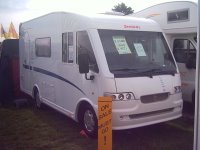 Motorhomes & Camper Vans appeal in as many different ways as there are people wanting one, therefore no ‘one fits all ’option is possible. When the motorhome and situation are compatible they are an excellent tool, providing unrivalled freedom and excellent after purchase economy.
Motorhomes & Camper Vans appeal in as many different ways as there are people wanting one, therefore no ‘one fits all ’option is possible. When the motorhome and situation are compatible they are an excellent tool, providing unrivalled freedom and excellent after purchase economy.The following is a highly cut version of Chapter two of Go Motorthoming Europe. We do not intend it to be a complete guide, more an introduction.
Abridged from Chapter 2 of Go Motorhoming Europe - Buying Your Motorhome
Motorhome manufacturers offer over 1000 new models and there are over
50 years of earlier models to chose from. Whether you are one of the 8000
Abridged from Chapter 2 of Go Motorhoming Europe - Buying Your Motorhome
Motorhome manufacturers offer over 1000 new models and there are over
50 years of earlier models to chose from. Whether you are one of the 8000
people a year who buy new or prefer second hand, the following information will help you think about the right questions.
Motorhome Classes A B C
Motorhome Classes A B C
Motorhomes are divided into three main categories, referred to as
classes A, B and C. Camper vans are B class motorhomes
Most motorhomes utilise an existing light commercial vehicle
engine and chassis. Commonly used are Fiat-Citreön-Peugeot,
Ducato-Relay-Boxer built in the same Sevel factory. Others
include Mercedes Sprinter, Iveco Daily, VW Transporter and
Renault Master. Some motorhomes have an AL-KO galvanised chassis.

A-Class
A class represents all motorhomes that are ‘coach shaped’ the smooth lined body added to a bare chassis cowl. A class motorhomes are prefered by people going full-timing, but are the most expencive motorhome class.
.
B-Class
B Class these are panel vans (such as transit vans) fitted out as motorhomes.
These are also called day-vans and camper vans.
B-Class
B Class these are panel vans (such as transit vans) fitted out as motorhomes.
These are also called day-vans and camper vans.
C-Class
C class refers to a chassis cab conversion with purpose built ‘caravan’
body attached.
Buying Considerations
Budget
Consider both the purchase price and running costs. As prices range from
£1,000 to over £1,000,000 it is easy to become carried away, and you will
probably find you need to spend more than you originally thought. Factor in
insurance, servicing and recovery charges as well as fuel economy.
Condition
Check the overall condition of the motorhome including; chassis/underneath, engine and mileage. Check the seals and trims on the outside for cracks, sun damage, knocks and scrapes. Inside the motorhome check carpets, cupboards, handles and upholstery, be aware of any personalisation. Damp is a problem in older motorhomes but less so in camper vans but must be checked for, thankfully except in extreem cases can normally be cured. Damp in motorhomes has a distinctive smell, mildew in cupboards is a sign but an inexpensive damp metre is worth having. Motorhome floors can de-laminate giving a bouncy feeling, again this can be cured. Wear and tear should be in line with the age of the motorhome. Ensure, by testing, that all gas/electricity parts are working. An older motorhome or campervan in excellent condition may be preferable to a younger one in poor condition.
Motorhome Living Accommodation
Condition
Check the overall condition of the motorhome including; chassis/underneath, engine and mileage. Check the seals and trims on the outside for cracks, sun damage, knocks and scrapes. Inside the motorhome check carpets, cupboards, handles and upholstery, be aware of any personalisation. Damp is a problem in older motorhomes but less so in camper vans but must be checked for, thankfully except in extreem cases can normally be cured. Damp in motorhomes has a distinctive smell, mildew in cupboards is a sign but an inexpensive damp metre is worth having. Motorhome floors can de-laminate giving a bouncy feeling, again this can be cured. Wear and tear should be in line with the age of the motorhome. Ensure, by testing, that all gas/electricity parts are working. An older motorhome or campervan in excellent condition may be preferable to a younger one in poor condition.
Motorhome Living Accommodation
.
The Compromise
Compromise is the only word that explains the situation. Thousands of
Compromise is the only word that explains the situation. Thousands of
motorhome layouts have been designed and continue to evolve but there is
no easy way to squeeze a kitchen, bathroom, dining room, lounge and
bedrooms into a motorhome, so try not to be too ridged, as none of them will be perfect.
Bathroom - Commonly camper vans do not have a separate shower or a
Bathroom - Commonly camper vans do not have a separate shower or a
toilet, those who can rough it will survive without, but in reality this is
inadequate if you are concidering European touring or non campsite based holidays.
Bedroom/sleeping - Poor sleep can be a big problem when away in your
Bedroom/sleeping - Poor sleep can be a big problem when away in your
motorhome, roughing it for a week can be fun, but after a month you may
not be laughing. Many people prefere a fixed or over cab bed, both are great but still have issues.
Kitchens - Can be cramped so ensure there is enough space to prepare a
Kitchens - Can be cramped so ensure there is enough space to prepare a
meal, but as with bathrooms they only need to be just big enough.
The above are likely to be your first considerations when purchasing a motorhome and Go Motorhoming Europe unravels all these and many other considerations you need to know to ensure you buy a safe, legal, comfortable and manageable motorhome or camper van.
The above are likely to be your first considerations when purchasing a motorhome and Go Motorhoming Europe unravels all these and many other considerations you need to know to ensure you buy a safe, legal, comfortable and manageable motorhome or camper van.
Wait a Moment What About Weight?
.
Weight Explained
Maximum Technically Permissible Laden Mass (MTPLM)
Maximum Vehicle Weight, Gross Vehicle Weight (GVW), and
Maximum Technically Permissible Laden Mass (MTPLM) all refer
to the legal maximum loaded weight including all occupants of a
motorhome. Converters of motor caravans can have the vehicle weight
Maximum Technically Permissible Laden Mass (MTPLM)
Maximum Vehicle Weight, Gross Vehicle Weight (GVW), and
Maximum Technically Permissible Laden Mass (MTPLM) all refer
to the legal maximum loaded weight including all occupants of a
motorhome. Converters of motor caravans can have the vehicle weight
re-assigned both up and down. The MTPLM should not be confused
with the Gross Train Weight (GTW) a higher figure that specifies the
maximum combined weight of the motorhome when towing a trailer.
Payload
We cannot stress enough how important it is for you to understand payload, and we make reference to it throughout the book.
Payload refers to the leftover weight between an empty motorhome (as calculated by manufacturers) and fully loaded to its specified MTPLM. We believe the payload should be sufficient in normal use to prevent you exceeding the MTPLM.
Unfortunately this is not as straightforward as it seems as manufacturers include or exclude different items into the empty
Payload
We cannot stress enough how important it is for you to understand payload, and we make reference to it throughout the book.
Payload refers to the leftover weight between an empty motorhome (as calculated by manufacturers) and fully loaded to its specified MTPLM. We believe the payload should be sufficient in normal use to prevent you exceeding the MTPLM.
Unfortunately this is not as straightforward as it seems as manufacturers include or exclude different items into the empty
weight that is known as Mass In Running Order (MIRO).
Mass In Running Order (MIRO)
MIRO refers to the entire manufactured weight of a motorhome and the equipment required to operate and in the case of motorhomes includes ‘essential habitation equipment ’.
Currently each manufacturer interprets the regulations differently. Therefore motorhomes bought before harmonization and then and subsequently second-hand may have different MIRO and payload calculations. (This is a big subject and is vital to understand. We have produced a detailed chart of 70 motorhomes out of the 1000+ 2005 & 2006 new motorhomes you could buy that will provide you with sufficient payload).
Axle weights
Axle weights may total more than the maximum vehicle weight
Mass In Running Order (MIRO)
MIRO refers to the entire manufactured weight of a motorhome and the equipment required to operate and in the case of motorhomes includes ‘essential habitation equipment ’.
Currently each manufacturer interprets the regulations differently. Therefore motorhomes bought before harmonization and then and subsequently second-hand may have different MIRO and payload calculations. (This is a big subject and is vital to understand. We have produced a detailed chart of 70 motorhomes out of the 1000+ 2005 & 2006 new motorhomes you could buy that will provide you with sufficient payload).
Axle weights
Axle weights may total more than the maximum vehicle weight
MTPLM as this allows for load variation. Motorhomes with 60%
overhang or longer increase the risk of exceeding rear axle weights.
The most likely thing to cause an overloaded rear axle is 2/300kg
of scooter and rack hanging off the back of a motorhome.
Axles are always numbered from front to rear 1-2 and 3 when a tag axle is present.
.
Size Matters!
Wheelbase, Overhang and Clearance
Wheelbase is the distance between the centre point of the front and rear wheels of a motorhome. Overhang; the distance from the centre point on the rear wheel to the rear of the motorhome, ideally this should be less than 55 per cent of the wheelbase to allow for towbars or bike racks, however 60 per cent is the recognised maximum legal limit. We once measured a factory standard motorhome with a 71 per cent overhang.
Size (UK Maximums)
In the United Kingdom the maximum permissible size of a motorhome is 12 metres (39 ’4") long and 2.55 metres (8 ’4") wide.
Six metres is the benchmark between medium and large motorhomes. Campsites, road tolls, ferries, insurance and recovery
prices are normally fixed for motorhomes up to six metres.
The above section briefly explains some of the legal issues of buying and using a motorhome. Ignoring these points could lead to you not being recovered buy your breakdown company, not being covered by insurance if involved in an accident or traveling illegally and having to answer to the police.
Go Motorhoming Europe also reveals many other factors involved in buying a motorhome including: The availability of parts,
fuel – whether your motorhome should run on diesel, Petrol or LPG, Left or right hand motorhomes, accessories…
The conclusion
The conclusion
We said at the start that this is a highly cut version of chapter two of Go Motorhoming Europe. We are repeatedly thanked and told that reading Go Motorhoming Europe has completely made people re-think what motorhome they thought they wanted and that it will probably save them thousands of pounds and countless of hours of research. We expect you to go away and try to find the answers to your questions but remember Go Motorhoming Europe is the only complete guide to buying, using and enjoying your motorhome. The answers are in one convenient place and the choice is yours but for the sake of £9.99 there really is no choice.
.
For more informatio follow this link:-
.
.